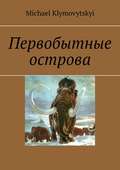
Michael Klymovytskyi
Mammoth House
Chapter 1. Mammoth House
The camp was located on the high bank of the River, ending with a steep rocky cliff. On the contrary, through a narrow channel, there was a large wooded island, followed by another, and even further the mouth of a river tributary. And further down to the horizon, loess hills and boulders left by the glacier stretched along the left bank.
The camp consisted of several groups of huts resembling Chukchi yarangs, in which walrus skins were stretched on the skeleton of whale ribs, with the difference that there were bones of a mammoth and a woolly rhinoceros. Excavations show that the vertebrae and pelvic bones of these animals were laid out in a circle with a diameter of 3-4 m, so that the ribs from the vertebrae closed at the top, forming a cone under the roof. The two-meter-long mammoth tusks probably formed the entrance to the dwelling. The yarangs were arranged in groups close to each other, and, perhaps, were connected to maintain heat from bonfires that were kindled in the central depression lined with stones.
Above, apparently, was a hole for the exit of smoke. The skeleton of bones was covered with animal skins with fur inside. On the floor, too, lay the skins with their fur up.
Women from men dressed in the same skins could only be distinguished by the absence of beards. On the occasion of the return of deer hunters, the entire population of the camp gathered at the site of a large bonfire, and with guttural shouts greeted the Father with his sons. A headdress of white foxes stood out a woman – the leader of the tribe or Mistress.
. The mother of the tribe was the old female mammoth (living totem), living in a corral of large stones. Chains of smaller stones went far into the steppe – the tundra, forming pens for deer and musk ox. The gaps between the boulders were closed by thorny branches and deadwood. These were titanic structures created by the first people. In addition to Mom, the tribe had four more tamed mammoths for her daughter, who grazed freely and even brought Mom bunches of branches and grass.
In addition to the leader, the father's father led the tribe, who was the guardian of the totem – the shaman. Under the rock behind the camp there were ledges and depressions, painted with ocher with images of hunting scenes and the domestication of animals. Here on the ledges were workshops for the production of stone tools: axes, arrowheads and spears, scrapers for cleaning hides, knives and others. This is where the Father and sons came after hunting deer to tell or draw about this to the grandfather-shaman.
The speech of the first people was poor in sounds and included many gestures. All women were addressed with the sound "I", with different intonations depending on age and rank, since they stood at the head of families, clans and the whole tribe.
Yarangi were also built in groups by birth and each family had a family: a woman, her children, her kind of husband, who was in the same rank as children. Mothers prepared sons for other families and gave them cattle and other property.
Father and his sons ate long fried meat, smoked and dried fish with steamed blueberries and blueberries and baked calamus tubers. And, climbing under the skins, they fell asleep under the howl of a spring blizzard, and could sleep for several days in a row, because they were very tired of deer.
The tribe collected fish at the rapids of the river. Ice hummocks exploded there all winter, and threw fish on coastal stones and on the island, and froze them. This was used by foxes and other animals. In the summer, when the river opened, fish were caught in wicker baskets and buried in pits with permafrost.
Several woolly rhinos (the first heralds of the spring migration of animals) appeared on the island and ate gnats. Along with mammoths, cave bears and lions, a contemporary of an ancient man in the last ice age was a rhino overgrown with wool – elmasater. In size, it was more than an African rhino weighed up to four tons. But since he lived in a harsh climate, his body was covered with thick dark brown hair.







